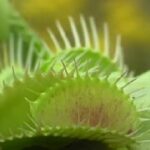As an Amazon Associate, this site earns commissions from qualifying purchases. For more details, click here.
Butterworts may not be as popular as Venus flytraps, but when it comes to eating bugs these plants can hold their own. But just how effective is the pinguicula when it comes to flies? Can they eat these common household pests and help you get rid of them?
The sticky leaves on butterworts traps flies the same way a flypaper does. Once the insect is caught, the plant releases digestive enzymes to break down its tissues in order to eat it.
Why Do Butterworts Eat Flies?
Flies and other bugs provide butterworts with nutrition. These plants grow in poor soil so they take nutrients from small insects. When a pinguicula catches a fly, its tissues are dissolved. The plant absorbs this solution and extracts nutrients from it.
Butterworts use photosynthesis to make glucose, which functions as plant food. While glucose does a lot for plants and is essential, nutrients provide extra resources. If pinguicula was a car, nutrients and glucose would be the fuel that powers them.
Can butterworts survive without eating bugs? Probably, but it will grow slowly and be more vulnerable to infection. Other carnivorous plants have proven capable of surviving with little to no insect nutrition, so it is possible.
However, butterworts will benefit from the nutrition provided by insects. Think of a regular houseplant for instance. We use fertilizers to stimulate its growth and development. Even under sunlight, plants will not last when grown in poor soil.
Butterworts on the other hand, only grow in poor soil. But the fact that these plants developed traps suggests they do need nutrients. So it makes sense to let the plants feed.
If your pinguicula grows in an ideal location, nutrition is probably not as important. With ample sun, water and air, your plant should be live, albeit grow slowly. But as the weather changes, so does the amount of resources available for the plant.
If you want vibrant and healthy pinguicula weser for instance, you have to provide as many sources of food and nutrients as possible. You should not overfeed your butterworts, but ensure they have access to food and nutrition.
While some may debate whether butterworts need nutrients or not, you can just focus on providing them with the environment, food and nutrients for growth. Do this and your plant will thrive and live for a long time.
How Butterworts Eat Flies
Butterworts have developed a simple but very effective way of luring, catching and eating insects. It is not surprising that flies are regular prey since their trap works like flypaper. Both butterworts and sundews are called flypaper plants because of their trapping methods.
Pinguicula plants secrete sticky substances ( called mucilage) on their leaves. Flies and other insects are attracted to this substance. When a fly tries to sip the mucilage, it gets stuck. Think of how a flypaper traps flies and you have an idea of how butterworts trap their prey.
The more the fly struggles, the more it gets stuck in the mucus. Some butterworts can curl their leaves and increase the mucus trapping the fly.
When the fly is completely trapped, the pinguicula will release its digestive juices. These enzymes cover the fly and dissolve it. These enzymes are capable of breaking down insect tissues into a liquid-like state. However it cannot dissolve hard shells which is why cockroaches and beetles are usually half eaten.
After the fly tissues have been broken down, the plant eats it along with the digestive enzymes that were released. Nitrogen, phosphorus and other nutrients are released into its system, ready to be used.
The time it takes to digest insects depends on many factors. How hungry it is, its health, how many insects it has eaten and so on. But do not be surprised if it takes a while. This is normal especially if there are a lot of insects trapped on its leaves.
How Many Flies Can Butterworts Eat?
Butterworts can catch a lot of flies because of their traps. Their leaves are natural flypapers that attracts not just flies but other insects as well.
You do not have to feed butterworts if it is outdoors. Its leaves will lure flies and other insects nearby so no help is needed. Do not be surprised if you see several bugs caught in your pinguicula after just a few days.
If you prefer to keep your butterworts indoors, you have two options. First, leave the plant on an open, sunny window sill. Your plant will have no problems catching the attention of flies and other insects so no hand feeding needed.
If your pinguicula is in a terrarium, you have to feed it every two to three weeks. Do not worry about the exact number of bugs you have to give. Just a few will be enough for these plants.
Other Food Options
Aside from insects, you can also give fish food or worms to butterworts. Live mealworms are the most nutritious but can be messy. Freeze dried mealworms is a better option. They are healthy for butterworts, widely available and have a long shelf life.
Fish food are also good for pinguicula as well as other carnivorous plants. You just drop a few pellets on the leaves and let the plant eat it.
As winter approaches, butterworts prepare for dormancy. During winter, Mexican butterworts drop their meat eating leaves in favor of succulents. Others discard all leaves and produce a hibernacula. There are also species which maintain their carnivorous leaves the entire year.
As you can see, pinguicula handle dormancy in different ways. Check what type of pinguicula you have so you can get an idea of what to expect. Majority of the time though, butterworts stop eating during this period. Even those that keep their carnivorous leaves slow down during winter. But when spring comes the plant will regain its appetite.
Why is My Butterworts Not Eating?
There are many reasons why a pinguicula may stop eating. You have to examine the plant carefully and assess the situation. Here are some likely reasons and the best possible solutions you can try.
Dormancy .Mexican butterworts like pinguicula balcanica do not go to sleep in winter. Instead they shed off their carnivorous leaves and grow non-carnivorous succulents. These leaves cannot eat meat. Other butterworts get rid of all their leaves so there is no way they can eat.
Overfed. Butterworts only need a limited amount of nutrients. Once they have reached this quota, they may no longer eat any bugs. Also keep in mind that butterworts have to use a lot of resources to digest food. If it is already weak, it will not eat anymore.
Infection. Carnivorous plants will not eat when they are sick. Infection can come from fungus or bacteria.The chemicals in tap water might harm it as well. Signs of a sick pinguicula include faded colors, lack of mucus on the leaves and sometimes a foul smell.
Poor Environment. Mexican butterworts prefer tropical climates. Keep the temperature at 60 F minimum and no higher than 80 F. That should be just right for these plants. Humidity is not a big factor. All butterworts need is around 20% and they will thrive.
If the conditions are favorable, pinguicula will have no trouble eating flies and other bugs. But under poor conditions, its appetite will be affected. This is why it is so important that you take the time to choose its location.
Period of Adjustment. If you just bought a potted pinguicula, do not worry if it refuses to eat right away. The plant is still trying to get over the shock of its new surroundings. Give it enough time and soon you will see the plant secrete mucus on its leaves and drawing bugs.
Conclusion
The nice thing about pinguicula is they are low maintenance. Once set up in a healthy environment, your butterworts will attract flies as well as other annoying pests. Not only do you get rid of them but your plant also receives plenty of nutrients.

My fascination with carnivorous plants began many, many years ago with Venus Fly Traps. Now I am more than happy to impart what I know with other enthusiasts and those who are curious about meat eating plants.



